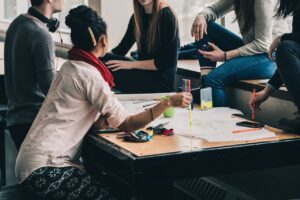More and more young people see themselves as non-binary. They do not feel either like a boy or a girl. It is a discussion that schools cannot ignore anymore. According to some schools, there is a non-binary student in every class, yet there are also school communities that ignore their presence. On Purple Friday, many schools pay attention to their lhbti students.
According to research, 0.7 percent of high school students feel different from their assigned gender. How many of them see themselves as non-binary is not entirely clear. Many schools do not want to give grades for privacy reasons.
Marieke Theeuwes van Lierop of the Montessori College in Eindhoven arranged a workshop for teachers about gender identity and sexuality. On Friday there will be a rainbow crosswalk in the schoolyard. Posters about gender and sexuality are hanging in the hallway. “There is a lot more attention for it and you notice that,” says Marieke.
The youth series SpangaS introduced the first non-binary character, Lesley, last year. Famous people like singer Demi Lovato and presenter Raven van Dorst identify themselves as non-binary. Originally from Brabant, writer Marieke Lucas Rijneveld says, “I am neither a boy nor a girl. I am an in-between person.”
Joep Roeffen, clinical psychologist and program coordinator of the Gender Team South Netherlands says, “Non-binary people become more visible and then you notice that others start thinking about themselves. We have all been brought up with the idea that there are only men and women. Now it appears that things can also be different. Certainly, on the Internet, there are many examples. So the subject is no longer forbidden. There are children and teenagers who watch SpangaS and think: that’s possible too.”

The Sint Lucas creative vocational school in Eindhoven states that there are some non-binary students in every class. The school has a clear policy: “If the student wants to, the call sign in the tracking system is changed. If a student wants, the gender is also changed. We also address the student in the way he, she or they want,” says a St. Luke’s spokesperson.
Roeffen: “The word non-binary has now become established. Young people pick up certain habits more easily. For example, they ask each other how they want to be addressed. That is a question that others do not ask. I see you as a woman so I’m not going to ask if you want to be addressed in the same way. That habit of asking is important to me.”
There are also school districts that state that there are no non-binary students in their schools. Many schools prefer not to address the issue at all due to student privacy concerns. They do not have a clear policy around the issue.
Roeffen states that the group of non-binary people is increasing very much worldwide. “Fifteen years ago, non-binary people existed but there was little visibility and little attention to them. In the last five to ten years, we are seeing a lot more nonbinary people.”
The reason? That is not so easy to explain. “We don’t know that very well. It’s an ongoing development. In 2016, there was a world congress on the subject. Back then, the American colleagues said: a third of all young people identify as non-binary. I have to admit that at the time I found that an incredible statement, I thought: that’s a lot. But in the meantime, you notice the big increase here too.”
There is definitely a role for the schools regarding this topic, Roeffen thinks. “You can expect schools to take up this theme. After all, it’s useful that attention is paid to it not only on TV and at home, but also at school.”
Source: Omroepbrabant.nl
Translation: Chaitali Sengupta. She also gives online INBURGERING classes.
















